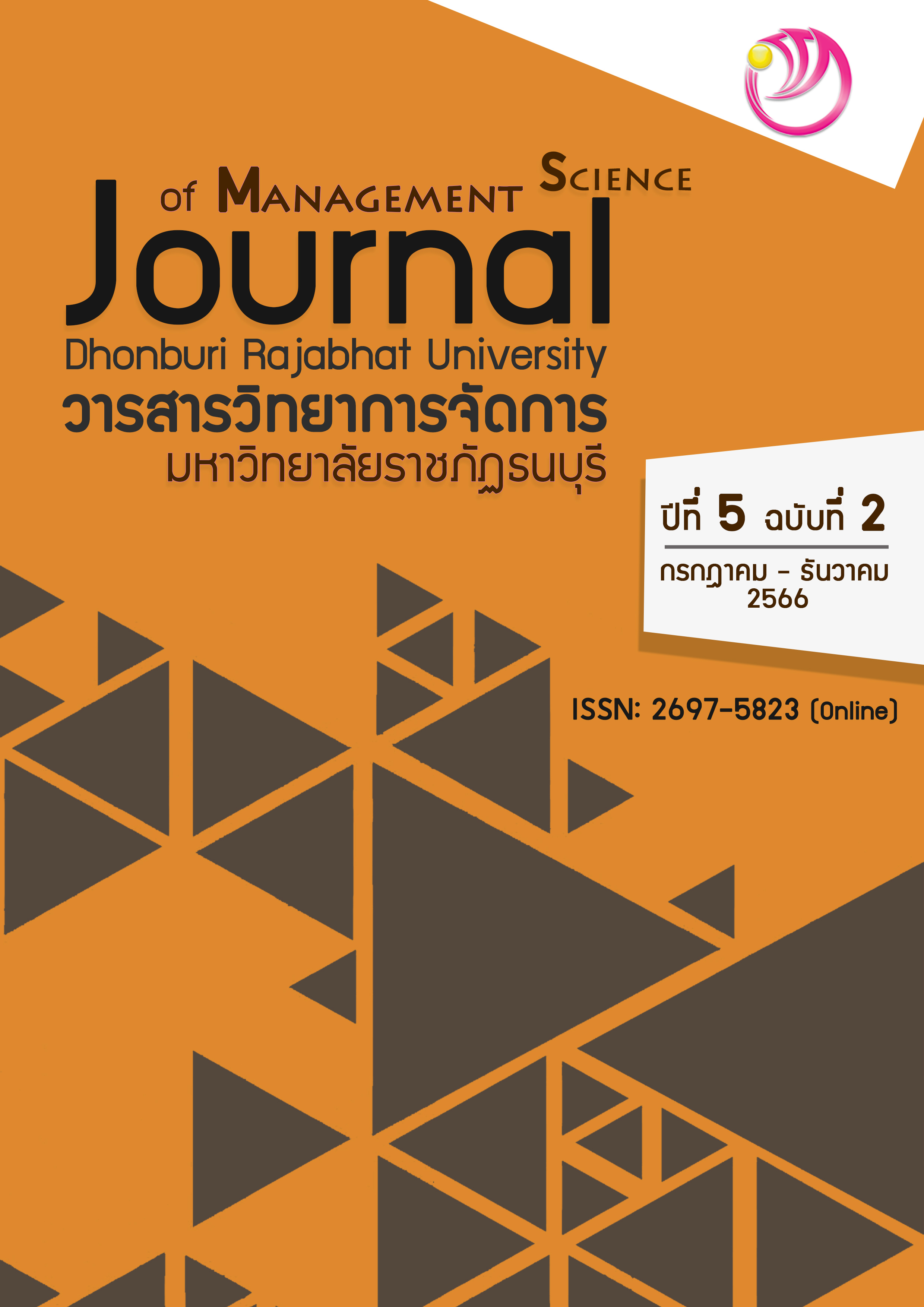Conceptualization of Thai Cuisine Images Through Sustainable Storytelling
Keywords:
Concept, Thai Cuisine Image, Sustainable StorytellingAbstract
This research is a qualitative study with the following investigation objectives: (1) the perception of Thai food and the consumption behavior of Generation Z. (ages ranging from 11-26 years old or were born between 1997-2012) (2) the concept of Thai food. (3) the significance of sustainable storytelling in promoting Thai cuisine and (4) guidelines for creating concepts and images of Thai food through sustainable storytelling. The primary sources of information included representatives from government agencies, educational institutions, cooking institutes, instructors, and students enrolled in Thai food courses, totaling 16 participants. The research employed semi-structured interviews as the primary data collection method. The data were analyzed through content analysis and presented in an essay format.
The results found that 1) perception of Thai Food and Generation Z Consumption Behavior (2018-2023): Thai cuisine has gained considerable popularity among foreign tourists with the active support from government agencies that have promoted food as a part of Thailand's Soft Power strategy. However, it was evident that Generation Z displayed a lesser degree of familiarity and interest in Thai cuisine. This lack of engagement could be attributed to the prevailing notion that Thai food involves complex cooking processes and is time-consuming to prepare. Additionally, there were instances where Generation Z found the taste of Thai food unappealing, were unfamiliar with the food, or simply felt uncomfortable with the unfamiliar flavors. Nonetheless, there were segments within Generation Z who consumed Thai food as a result of social trends prevailing during that time. 2) Concept of Thai Food: Thai food is a culinary tradition that has been passed down from generation to generation, embodying an essential element of the nation's cultural heritage. It is renowned for its distinctive flavors, uniqueness, and its status as a culinary symbol of the nation. Thai cuisine can be broadly categorized into two primary types: savory dishes and desserts. 3) The significance of Sustainable Storytelling for Thai Food: It was found that Thai cuisine, with its deep historical roots and traditional cooking methods, holds immense cultural significance. Sustainable storytelling is essential to raise awareness, generate interest, and stimulate the appetite of Generation Z for Thai food. 4) Guidelines for creating the Thai Food Image through sustainable storytelling: The research identified the pivotal roles that both public and private entities can play in promoting high-quality and sustainable storytelling about Thai cuisine. In addition to the Soft Power that Thai food holds, entrepreneurs involved in the Thai food industry are poised to be significant contributors in leveraging Thai cuisine as a form of Soft Power, effectively shaping the image of Thai food in a sustainable manner for consumers and Generation Z.
References
กนกพร กระจ่างแสง, กมลพิพัฒน์ ชนะสิทธิ์ และประสพชัย พสุนนท์. (2561). การรับรู้ภาพลักษณ์และอัตลักษณ์อาหารไทยที่ส่งผลต่อพฤติกรรมการบริโภคของวัยรุ่นในเขตกรุงเทพมหานคร. วารสารมนุษยศาสตร์และสังคมศาสตร์ มหาวิทยาลัยธนบุรี, 13(2), 47-57.
กิตติมา ชาญวิชัย และธีรพล ภูรัต (2563) การสร้างมูลค่าเพิ่มด้วยการพัฒนาความเป็นตัวตนที่แท้จริงให้กับอาหารท้องถิ่นในอำเภอเขาค้อ จังหวัดเพชรบูรณ์. วารสารบริหารธุรกิจ เศรษฐศาสตร์และการสื่อสาร, 15(3), 26-37.
นัทธ์หทัย เกาตระกลู. (2561). ภาพลักษณ์และคุณค่าที่มีอิทธิพลต่อผลประกอบการของโรงแรมราคาประหยัดในเขตอำเภอเมือง จังหวัดเชียงใหม่. วารสารบริหารธุรกิจเทคโนโลยีมหานคร, 15(2), 1-20.
ภูริทัต ว่องพุฒิพงศ์.(2563). ทฤษฎีโครงสร้างการเล่าเรื่อง (Storytelling). สืบค้นจาก https://pharmconnection.blogspot.com/2020/09/storytelling.html
มหาวิทยาลัยสวนดุสิต. (2565). สรุปผลการสำรวจ: อาหารไทย...เอกลักษณ์ไทย. สืบค้นจาก https://dusitpoll.dusit.ac.th/UPLOAD_FILES/POLL/2565/PS-2565-1669519887.pdf
ลลิลล์ณิฏา เย็นทลู. (2564). พฤติกรรมการบริโภคสินค้าของใช้ฟุ่มเฟือยของกลุ่มลูกค้า Gen Z ในเขตพื้นที่ปทุมวัน กรุงเทพมหานคร. หลักสูตรบริหารธุรกิจมหาบัณฑิต สาขาวิชาการจัดการตลาดดิจิทัล, วิทยาลัยบริหารธุรกิจนวัตกรรมและการบัญชี.
วงศ์ทิพย์ ถิตยสถาน. (2542). อาหารไทย-อาหารสุขภาพ. วิทยานิพนธ์, วิทยาศาสตร์มหาบัณฑิต สาขาอาหารและโภชนาการเพื่อการพัฒนา, บัณฑิตวิทยาลัย มหาวิทยาลัยมหิดล.
ศาตรา กระฉอดนอก. (2553). การจัดอาหารไทยแสดงออกซึ่งเอกลักษณไทย. วารสารอิเล็กทรอนิกส์ มหาวิทยาลัยศิลปากร (มนุษยศาสตร์สังคมศาสตร์และศิลปะ), 3(1), 64-78.
ศรุดา นิติวรการ. (2557). อาหารไทย: มรดกทางวัฒนธรรมของชาติ. วารสารวิชาการมหาวิทยาลัยราชภัฏพระนคร, 5(1), 171-179.
สถาบันอาหาร กระทรวงอุตสาหกรรม. (2565). สรุปภาวะอุตสาหกรรมอาหารไทยปี 2565 และแนวโน้มปี 2566. สืบค้นจาก: https://fic.nfi.or.th/upload/articles/1676969812_Board%20Food%20Industry_12.2022.pdf
สุภาณี ปัสสา. (2558). การรับรู้ภาพลักษณ์ของบริษัทการบินไทยจำกัด (มหาชน) ของชาวต่างชาติ. การค้นคว้าอิสระ. วารสารศาสตรมหาบัณฑิต สาขาวิชาสื่อสารมวลชน คณะวารสารศาสตร์ และสื่อสารมวลชน, มหาวิทยาลัยธรรมศาสตร์.
สำนักงานสภานโยบายการอุดมศึกษา วิทยาศาสตร์ วิจัย และนวัตกรรมแห่งชาติ. (2565). โมเดลเศรษฐกิจ บีซีจี. สืบค้นจาก: https://www.nxpo.or.th/th/bcg-economy/
Thailand Sustainable Food Systems. (2023). ระบบอาหารที่ยั่งยืนคือ. สืบค้นจาก: https:// thfoodsystems.com/sfs-is/
Chaisawadi, S., Thongbute, D., Methawiriyasilp, W., Pitakworarat, N., Chaisawadi, A., Jaturonrasamee, K., Khemkhaw, J., Tanuthumchareon, W. (2005). Preliminary study of antimicrobial activities on medicinal herbs of Thai food ingredients. Acta Hortic, 675, 111-114.
Supawat, N., and Sisikka, W. (2021). The Cultural Invention of Thai Royal Cuisine in a Creative-Economy Context. Journal of Business, Economics and Communications, 17(2), 84-100.
Tohtubtiang, K. and Anuntoavoranich, P. (2017). Factors determining value and consumption of Thai food: a structural model. International Food Research Journal, 24(4), 1383-1386.
Downloads
Published
How to Cite
Issue
Section
License
Copyright (c) 2023 Faculty of Management Science, Dhonburi Rajabhat University

This work is licensed under a Creative Commons Attribution-NonCommercial-NoDerivatives 4.0 International License.






